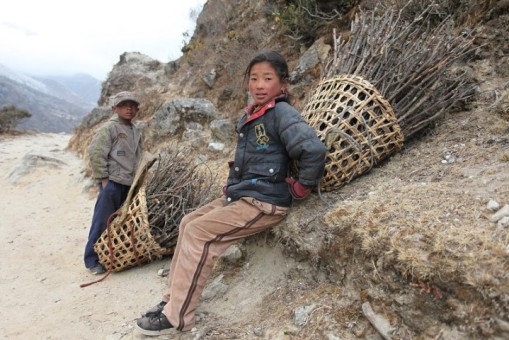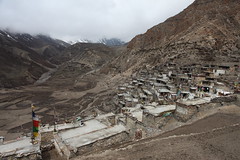What does a microfinance scheme have to do with snow leopard conservation? Quite a lot actually, as the first of two blogs from the Nangpa valley explains.
On Friday 14th we left Namche Bazaar for the Nangpa valley, the western part of Sagarmatha (Everest) National Park. This area is well away from the busy tourist trail to Everest Base Camp, and is quieter, less well-off and more dependent on agriculture and livestock. This valley was also were Tsering, one of our research assistants was from. As a local, he had spent a week with us making valuable introductions to contacts in the area, but now left due to prior commitments back in Kathmandu.

Because there are more livestock in the Nangpa valley there are also more incidents of snow leopards preying on them. The general consensus in the seven or so villages and hamlets that we surveyed was that each was losing four to five livestock – mostly young cattle – per year. Some of these were due to the snow leopard and some to the forest, or common, leopard. While it is virtually impossible to tell from a carcass which is responsible, the further above the tree line we got, the lower the chance that it was a forest leopard. Even the resident dog in Thamo village had been attacked, twice. Borrowing some of his feline assailants’ nine lives, he had lived to bark another day, twice.

To put all this in perspective, however, the main causes of livestock deaths in the area are not these two leopard species, but ageing, disease, accidents and bad weather. That said, the loss of even a single animal to one of these factors, or a predator, represents a significant loss to families with limited resources, especially if they don’t have access to the lucrative tourist trade. There is a compensation scheme for livestock killed by snow and forest leopards run by the National Park management but people told us that it involves so much hassle and cost that they don’t usually bother applying.
Enter the Snow Leopard Conservancy (SLC), a US-based snow leopard conservation organisation. Their Founder-Director, Dr Rodney Jackson, and Nepali Director, Dr Som Ale, had both given me valuable advice and direction in designing and setting up this study. To address the twin threats to local communities of poverty and snow leopard predation, the SLC set up an innovative microfinance scheme. These Savings and Credit Cooperatives (SCC) are now functioning in three settlements in the Nangpa valley, plus one in another valley here.

Microfinance works by making small loans and deposits available to people who normally wouldn’t be able to access the mainstream banking system. It’s been tried all over the world and has been shown to be an effective way of empowering local communities to work their way out of poverty. It provides money for things like small business start-ups, as well as savings in times of hardship.

What’s different about the SCC groups in the Nangpa valley is that they are run by the local people for the local people. The SLC provided the initial grant and employ auditors annually to check the books. Otherwise, the members, mostly women, save a fixed amount each month and, in turn, make small loans available to carefully vetted people in the community. 75% of the interest paid on these loans goes back to the cooperative members, while the remaining 25% goes into a community conservation and development fund. The members choose how to spend this, including on things like nature education camps for the young people in the area and traditional costumes so that they can run cultural shows for tourists. They’ve also set up their own compensation scheme for members who lose livestock to snow leopards.

The future of snow leopards depends, to a large extent, on them being regarded as assets to the people who co-exist with them, instead of liabilities. Innovative schemes, like the SLC’s Savings and Credit Cooperatives, which integrate wildlife conservation and human development, have a vital role to play in this. They contribute to this by reducing the risks associated with living alongside snow leopards, especially livestock losses. Snow leopards and their human neighbours are banking on the success of projects like this.





Reblogged this on Dr Jonny Hanson and commented:
In Snow Leopard Fieldwork Diaries 4 – The Snow Leopard Bank Ltd. – find out what microfinance has to do with macro-predators. And why both people & snow leopards are banking on the answer…